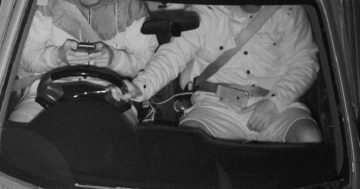
Mobile phone detection cameras may soon be introduced in the ACT. Photo: Supplied.
Motorists in the ACT who use their mobile phones while driving may soon have an extra deterrent with the ACT Government investigating the introduction of mobile phone detection cameras to help address the significant safety concerns around illegal phone use.
The funding was allocated in the recent mid-year budget and follows the introduction of mobile phone detection cameras in NSW. The NSW legislation came into effect in July 2018, enabling NSW to pilot world-first mobile phone detection camera technology between January and June 2019.
During the pilot stage, the cameras have already detected more than 100,000 drivers in NSW using their phones illegally.
The ACT Minister for Justice, Consumer Affairs and Road Safety, Shane Rattenbury, said addressing driver distraction is a high priority for the ACT Government.
“Distracted driving is not on. Drivers who engage in this practice are endangering the lives of everyone on our roads,” Mr Rattenbury said.
“To combat this significant road safety issue, the ACT Government is now exploring the possible future introduction of mobile phone detection cameras, similar to those rolled out in NSW.”
Research has shown that distracted drivers, such as those who look at their mobile phones while driving, are three times more likely to be involved in a crash.
“Drivers are continuing to use their mobile phones while driving. At 60km/h, looking at your phone for just three seconds means you are driving blind for 50 metres,” Mr Rattenbury said.
“These are measures that can be controversial, but I think the Canberra community would support these cameras because they want to be safe on the road, and they are tired of people driving dangerously and distracted.”
The first stage will focus on a framework for the possible introduction of the cameras into the ACT road environment, including assessing appropriate locations, identifying the most appropriate types of cameras for the ACT, and the privacy safeguards required.
This work will inform any legislative reforms required to enable the use of these cameras in the ACT in the future.
The ACT Government also recently made an amendment to legislation that allows an exemption for mobile phone use for professional drivers, such as rideshare drivers.
Another amendment allows ACT drivers to use their mobile phone for GPS purposes, provided the phone is securely affixed to the vehicle.
Any cameras deployed will complement existing police enforcement, which saw 1278 infringement notices issued for illegal mobile phone use on ACT roads in the 2018-19 financial year.
The fine in the ACT for touching your phone while in control of a motor vehicle is $447 or four demerit points. If the driver is using the mobile for social media or the internet, the fine goes up to $588 with a loss of four demerit points.
The Transport for NSW Centre for Road Safety said the fine for illegal mobile phone use in NSW is $344, or $457 if detected in a school zone. There is a five-demerit-point penalty for illegal mobile phone use, which increases to 10 demerit points during double-demerit periods.
“Texting, calling or even looking at your phone while driving is dangerous and continues to be a significant road safety concern for the community. Put your phone down,” Mr Rattenbury said.
NSW is the first state in Australia to prove this technology works and has implemented a statewide camera program.
A Transport for NSW spokesperson said the mobile phone detection camera system has been developed following a global search for the best available technology. The system incorporates a number of cameras and an infra-red flash to capture clear images of passing vehicles in all traffic and weather conditions.
“Artificial intelligence software analyses each image to determine those most likely to display illegal mobile phone use, as well as those with no evidence of illegal mobile phone use,” the Transport for NSW spokesperson said.
“Images that are automatically deemed likely to contain a mobile phone offence are verified by appropriately trained personnel. Images rejected by the artificial intelligence will typically be deleted within an hour of detection and without being viewed.”
Both fixed and transportable versions of the cameras use the same camera technology.



















